Art & Exhibitions
Robert Longo on Editing Eisenstein, Learning From Putin’s Russia, and Why ‘Making Art Is a Political Gesture, Period’
"Proof: Francisco Goya, Sergei Eisenstein, Robert Longo" is on view now at the Brooklyn Museum.
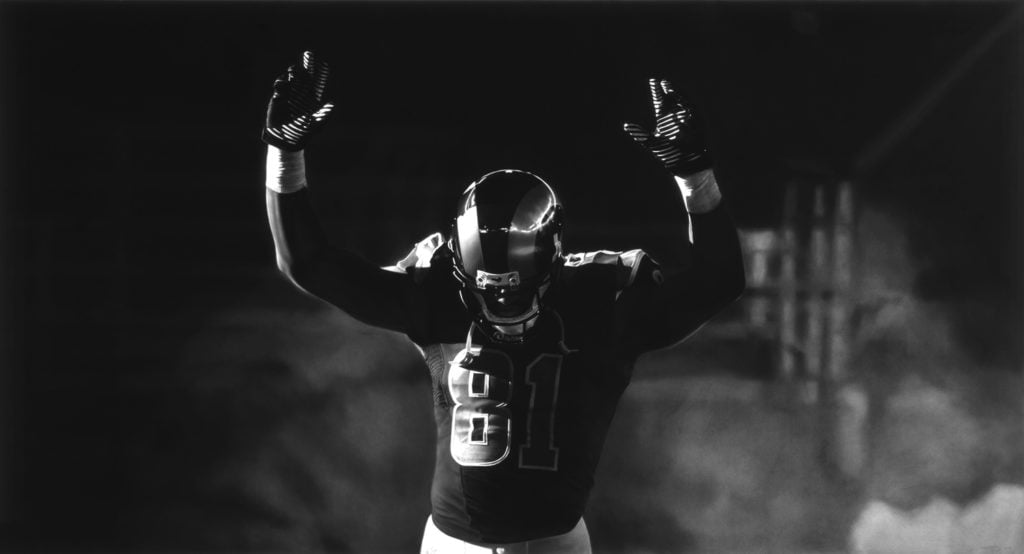
"Proof: Francisco Goya, Sergei Eisenstein, Robert Longo" is on view now at the Brooklyn Museum.

Robert Longo has for many years been making work that is dark, silky, and jaw-droppingly beautiful—black-and-white hyper-realistic images, often large in scale and impressive to look at from any vantage point. Up close, the work exposes carefully placed dusty marks; from afar they resemble giant gelatin prints.
Associated with the Pictures Generation, Longo has long made art by reworking found images for these dramatic drawings. Since the early aughts, the imagery Longo has looked to has become more decisively political—a tendency turbo-charged in recent years, as with his stunning image of St. Louis Rams football player Kenny Britt raising his hands in the “hands up, don’t shoot” pose associated with the 2014 protests in Ferguson, Missouri.
For the Brooklyn Museum’s new show, “Proof: Francisco Goya, Sergei Eisenstein, Robert Longo,” the idea of appropriating images takes on a whole new dimension. Conceived by the artist and curator Kate Fowle, the exhibition was first shown at Moscow’s Garage Museum of Contemporary Art last year. In effect, you could argue that he appropriates two other artists, remixing a selection of Eisenstein’s films and Goya’s famed etchings with his own drawings, creating a show that adds up to a reflection on how artists respond to the events of their time.
Recently, we met with the artist at the Brooklyn Museum to discuss “Proof,” his fascination with Goya and Eisenstein, and how his work has changed over the years.
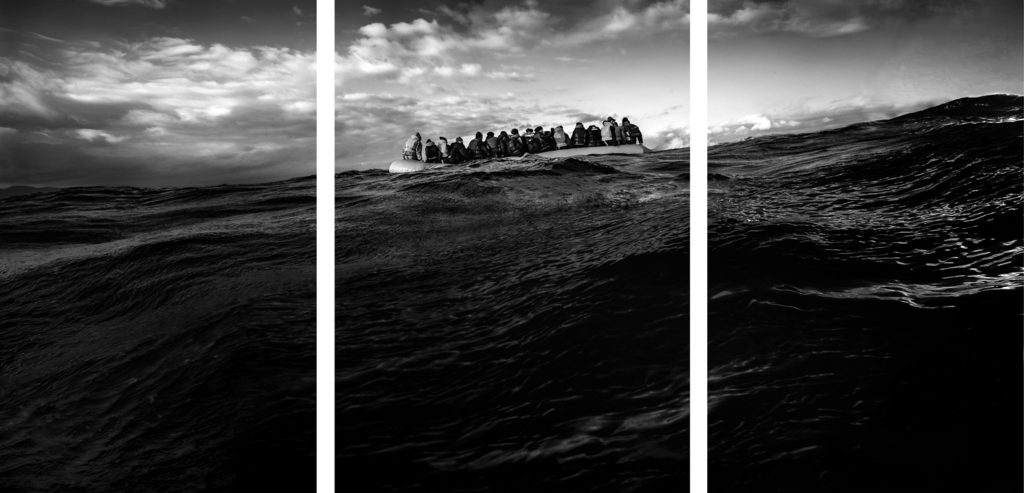
Robert Longo, Untitled (Raft at Sea) (2016–2017). Charcoal on mounted paper, 140 x 281 inches. © Robert Longo, Private European Collection. Photo: Courtesy of the artist and Metro Pictures, New York.
The first iteration of this exhibition was at Moscow’s Garage Museum. Can you tell us a little about how that show came together, how it came here to Brooklyn Museum, and your relationship to the works of both Goya and Eisenstein?
The co-curator of the show, Kate Fowle, came up with the idea of the artist responding to the time that they live in. That was the real genesis of the show. I also talked to her a lot about both Eisenstein and Goya because they’ve had a huge influence on me. What’s also interesting is that Goya had a huge influence on Eisenstein as well. So this idea of influence was also important to thinking about creating this exhibition. Originally when we did the show in Moscow at Garage Museum, we featured Eisenstein’s films alongside his drawings.
His drawings are not featured in this exhibition at the Brooklyn Museum, though.
No, because it’s not possible to loan “State” works between Russia and the US at the moment.
That’s so unfortunate.
As we started piecing it together, and thinking about the most appropriate film installation, we asked ourselves, “Should we show Eisenstein’s films in the theater with orchestras?” Then this idea of showing each film frame by frame, for six seconds each, came about—no sound, no subtitles—a way of highlighting the visual power of each frame of Eisenstein’s work.
When I was in school I worked for Hollis Frampton and Paul Sharits, and I saw all these guys make incredible structuralist films, which were non-narrative and about the medium itself. There was an artist, Ken Jacobs, who showed a film with what he called an anamorphic projector that would show the film one frame at a time. I thought this was a really great technique. “One day I’m going to use this,” I told myself.
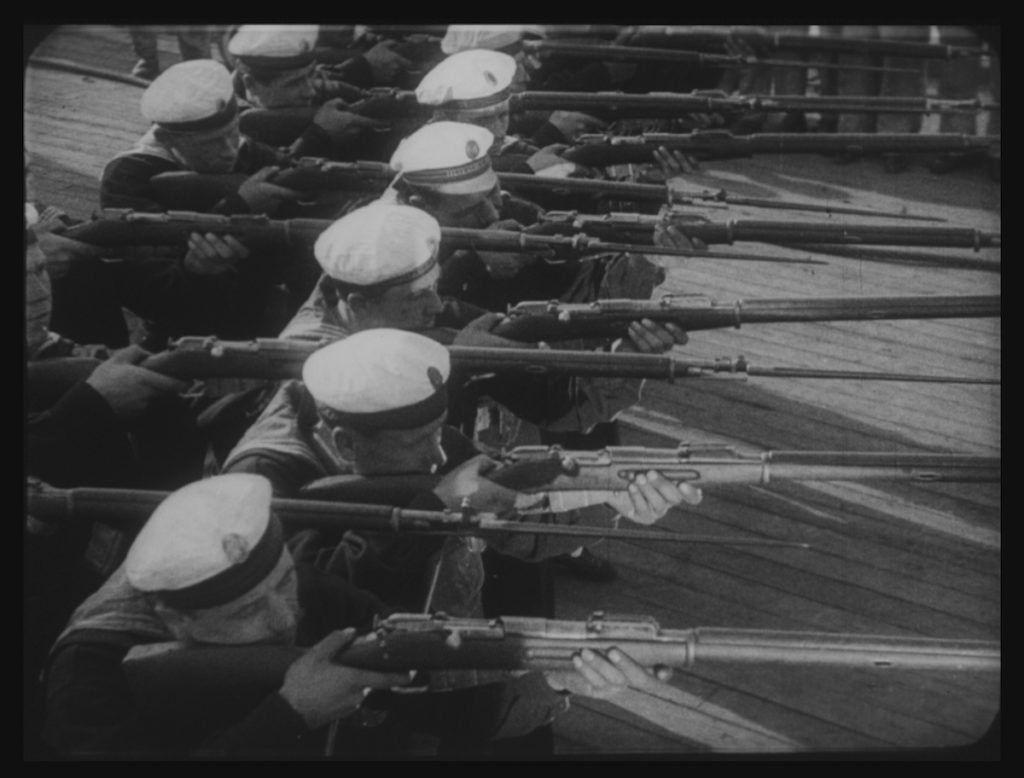
Sergei Eisenstein, Still from Battleship Potemkin (1925). Courtesy of Gosfilmofond, National Film Foundation of Russian Federation.
It also reminds me of Douglas Gordon’s 24 Hour Psycho, where he slowed down Hitchcock’s famous thriller. It has this wonderful dramatic effect, and in this case seeing Eisenstein’s Strike, October, Battleship Potemkin, and others all alongside each other, moving at that slow pace, is mesmerizing. It also really shows the through-line between his work and that of Goya’s and your own—the composition and the use of light in the images.
By slowing down Eisenstein’s films, you get so blown away by the images—his compositional elements are just so spectacular. Eisenstein is an artist who is never working so much from real life, but from the idea of composition. It’s also important to remember that these films were tools of oppression—
Right, they were propaganda films.
So how do you transcend that? By taking the sound and subtitles out? Basically, here, you see his films entirely as montage.
So in some sense it’s similar to your practice. Not only are you taking these films—I wouldn’t say appropriating them, but you’re manipulating them and making them your own in some way.
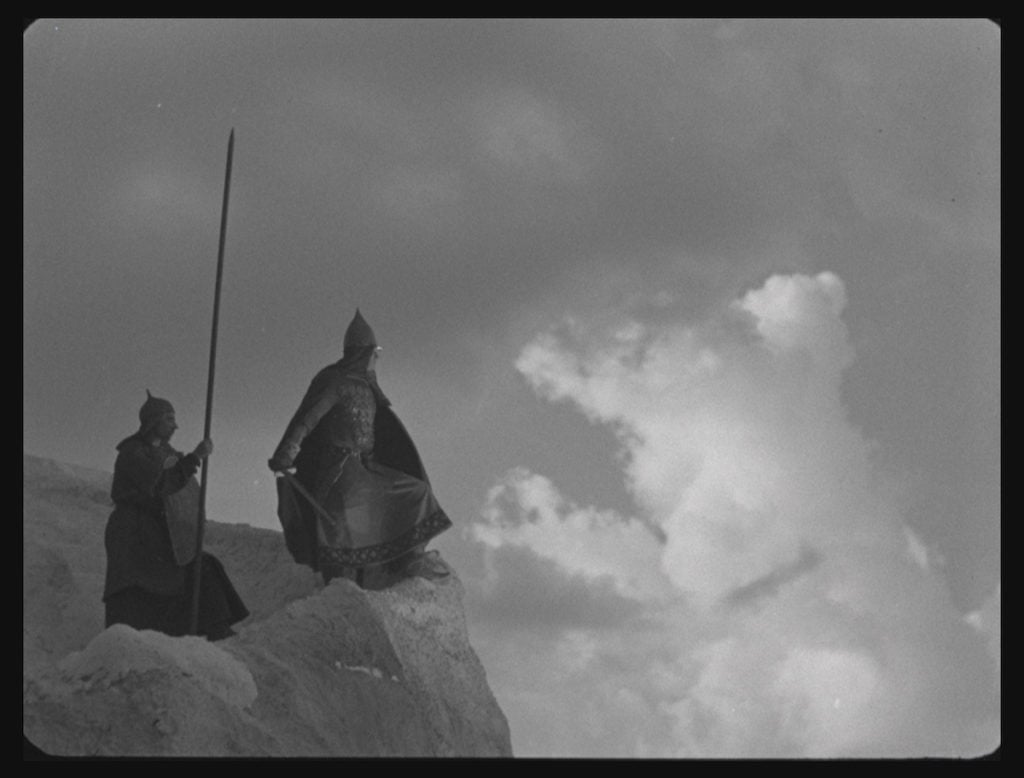
Sergei Eisenstein, still from Alexander Nevsky (1938). Courtesy of Gosfilmofond, National Film Foundation of Russian Federation.
Well, I’m only in the service of these artists. But before we did this I felt like, “Okay, so we’re fucking with the work of this cinematic giant. I need somebody connected to Eisenstein who will give me their blessings. Who do I talk to?” And Kate’s team suggested the leading expert on Eisenstein, Naum Kleiman, and we met him in Eisenstein’s old apartment, which you’re not allowed to go to.
Really?
Yeah. He said, “You can’t tell anybody you’ve been here.” And we had a cup of tea, some cookies, and we just sat there and talked.
When was this exactly?
This was maybe a year before we did the show in Russia. Kate and I went to all of the archives to do research: the Russian State Archive of Literature and Art, the Pushkin Museum, the Hermitage, and the State Central Museum of Contemporary History of Russia, which used to be called the Museum of the Revolution.
So Kate Fowle approached you to do this show and then you had free reign to do research on your own?
It was a collaboration. We talked a lot and we came up with this idea of doing a show with all the black-and-white images. And then I suggested this idea of how to do the films. I wanted the highest quality film too. I didn’t want DVDs from the store. The problem was that these films are in the State film archive outside of Moscow. So to get them to approve a direct transfer from the negative was a hassle, but it happened.
And Kate has this incredible team of people working with us in Moscow, and some of them are here in Brooklyn, helping out with this show too. My conception of Russia is very different after spending some time there. It’s an amazing country. The Garage team, and generally the people of Moscow, are young and enthusiastic, and speak English perfectly.
It was really funny too, because I lived with them through their elections—a few of the younger folks voted, but their parents didn’t because they don’t have voting in their history. “What’s voting? And who am I going to vote for when there is only one political party?”
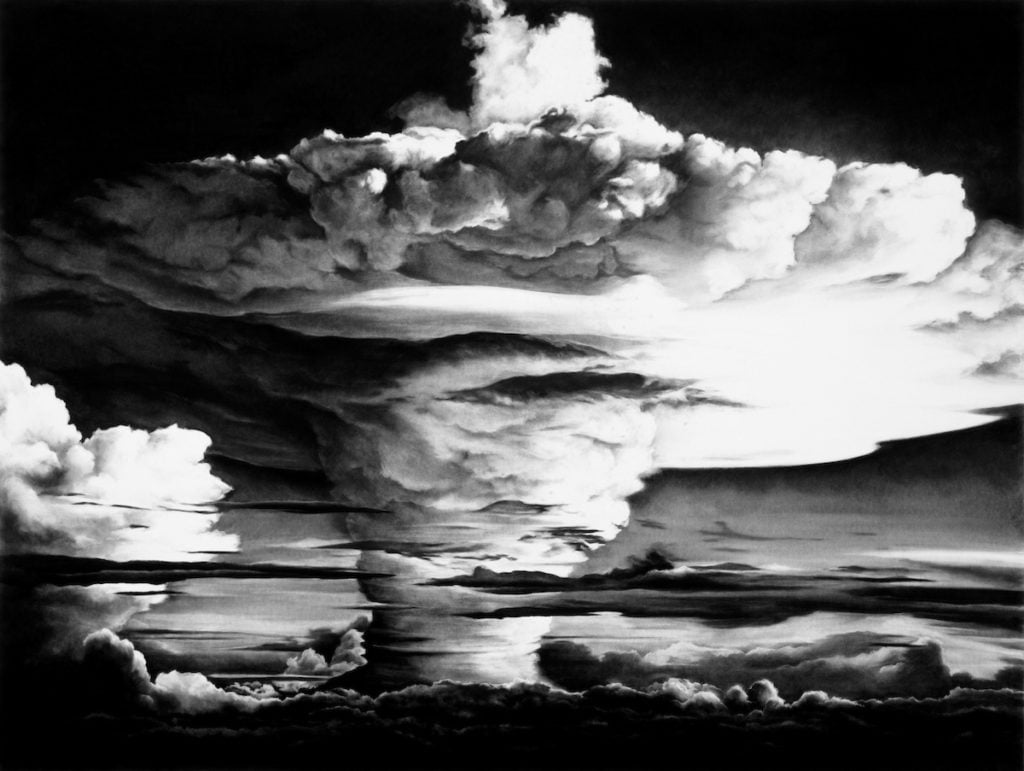
Robert Longo, Untitled (Mike Test/Head of Goya) (2003). Charcoal on mounted paper, 72 x 96 inches. Courtesy of Robert Longo. Photo: Courtesy of the artist and Metro Pictures, New York.
Then when Trump got elected I went back and it was really ironic. I wanted to ask them, “How do you live with Putin? Maybe you can teach me how to live with this guy.” It was really interesting. They were really great.
The next thing was Goya. “How do we do Goya?” His etchings. I always remember when you go to see etchings in museums there are always hundreds of them and your eyes get glassy, and you just don’t care anymore.
So the question was: How do we make a deliberate edit of those prints, his four famous series [Los Capricios (The Caprices), Los Desastres de la Guera (The Disasters of War), La Tauromaquía (The Act of Bullfighting), and Los Proverbios (The Proverbs)] in keeping with the relationship to Eisenstein, and to my work as well? So we looked at the edit of Goya in an almost cinematic way.
![Francisco de Goya, Where There's a Will There's a Way [A Way of Flying] (Donde Hay Ganas Hay Maña [Modo de Volar]), (1813-1820). From "The Proverbs (Los Proverbios; Los Disparates)". Open Access Image from the Davison Art Center, Wesleyan University; Photo: R. Lee.](https://news.artnet.com/app/news-upload/2017/09/EL158.60_DAC_1949-D3-7-13_001_OA-1024x747.jpg)
Francisco de Goya, Where There’s a Will There’s a Way [A Way of Flying] (Donde Hay Ganas Hay Maña [Modo de Volar]), (1813-1820). From “The Proverbs (Los Proverbios; Los Disparates)”. Open Access Image from the Davison Art Center, Wesleyan University; Photo: R. Lee.
We tried to find the right prints in Russia and I realized that some of those prints weren’t necessarily the best prints. Then one of Kate’s researchers found out that the Museum of the Revolution [now the State Central Museum of Contemporary History of Russia] had the complete set of Goya prints. They were the last official prints made with the original copper plates, before they were permanently retired. And the prints were given to Russia as a gift in 1937 to celebrate the anniversary of the Russian Revolution.
However, the Brooklyn Museum has some of the most extraordinary prints by Goya already in its collection. They are all artist’s proofs and so slightly different than the final version. It blows my mind because it means that Goya actually saw these prints himself.
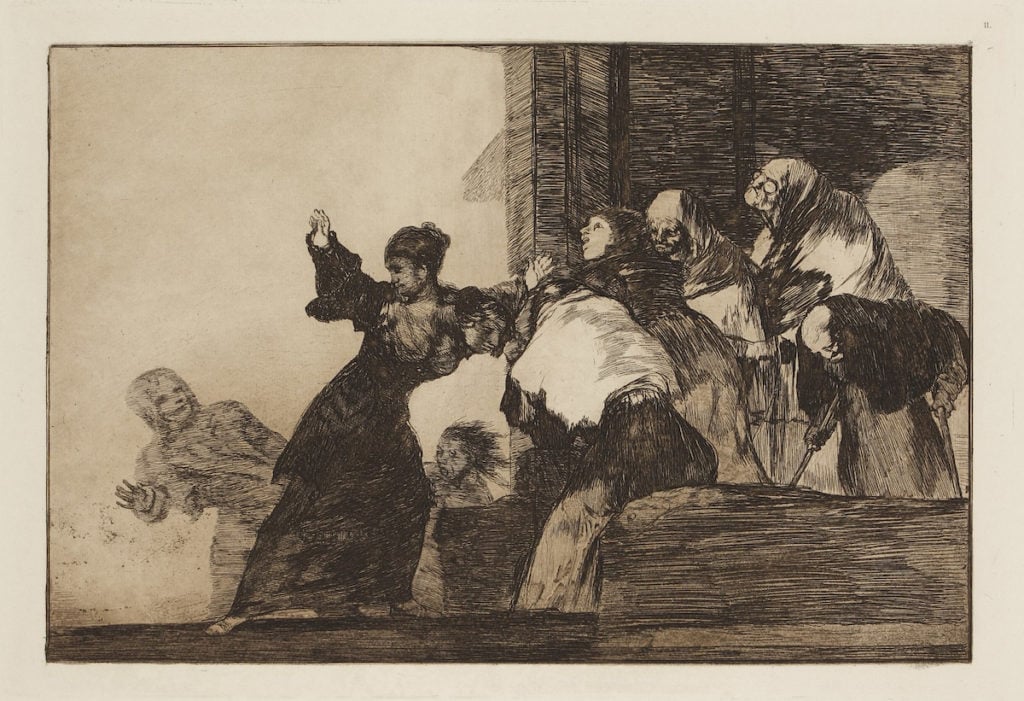
Francisco de Goya, Two heads are better than one, from the series “The Follies (Los Disparates)”, (1819-24). Courtesy of the Princeton University Art Museum.
So tell me, what’s the story behind the show at the Brooklyn Museum? How did it all come together?
Nancy Spector [the chief curator at the Brooklyn Museum] knew about the show early on.
Oh right. She wrote an incredible essay in the catalogue as well.
Yeah, Nancy was in contact with Kate. Also Anne Pasternak [the director of the Brooklyn Museum] had said she wanted to work with me on something. Nancy, who is very political, said “a show like this is needed right now,” in this political climate. Making political art is one thing, but responding to the political time you live in is a little different.
That’s an interesting way of looking at it. Can you say a little bit more about that?
The work in this show is political art, but it’s much more than that too. The problem with political art is sometimes it’s like you’re getting up on a soapbox and preaching to the converted. None of the work is simply documentary. Rather, the works in this exhibition are responses to the world. I think sometimes my work is like ripping chunks of the world out and shoving them in front of the viewer’s face and asking: “What do you think of this? What do you really feel? What is this?”
My work is about finding the balance between something that is both highly personal and socially relevant. Somehow we have to mediate between these two things. Making art becomes an issue of marrying a sense of humanity with a sense of justice in an image. You know what I mean? It’s really difficult. When I was younger my work was much more bombastic for sure, but I think it has gotten a little bit more subtle.
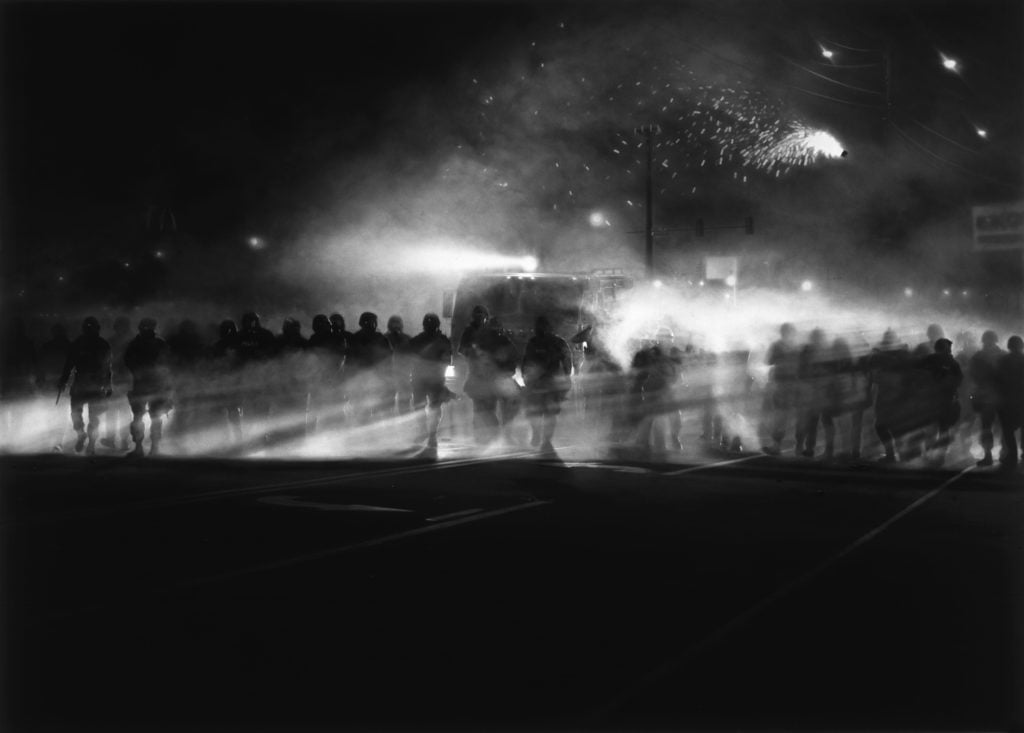
Robert Longo, Untitled (Ferguson Police, August 13, 2014) (2014). Charcoal on mounted paper, 86 x 120 inches. © Robert Longo, The Broad Art Foundation. Photo: Courtesy of the artist and Petzel, New York.
Correct me if I’m wrong, but wouldn’t you regard yourself as a political artist? I know you were talking about this difference between political art and making art that’s responding to the times. But in some sense there has been a shift in your more recent work. And by that I mean, your piece on Ferguson, the drawing of the refugees on the raft… I mean these are very political works.
I think making art is a political gesture. Period.
I grew up during Reagan, and I fucking hated Reagan. And Reagan was originally the guy who said, “Let’s make America great again.” Let’s not forget that. “Let’s return to traditional values,” was another Reagan phrase.
I remember saying, “What does that mean? Do we go back to slavery? What are traditional American values?” And the thought that someone could tell me that I can’t do what I do, was at the front of my mind. Freedom of expression became really important. That’s why the bullet hole piece [Untitled (Bullet Hole in Window, January 7, 2015)] becomes really important to me.
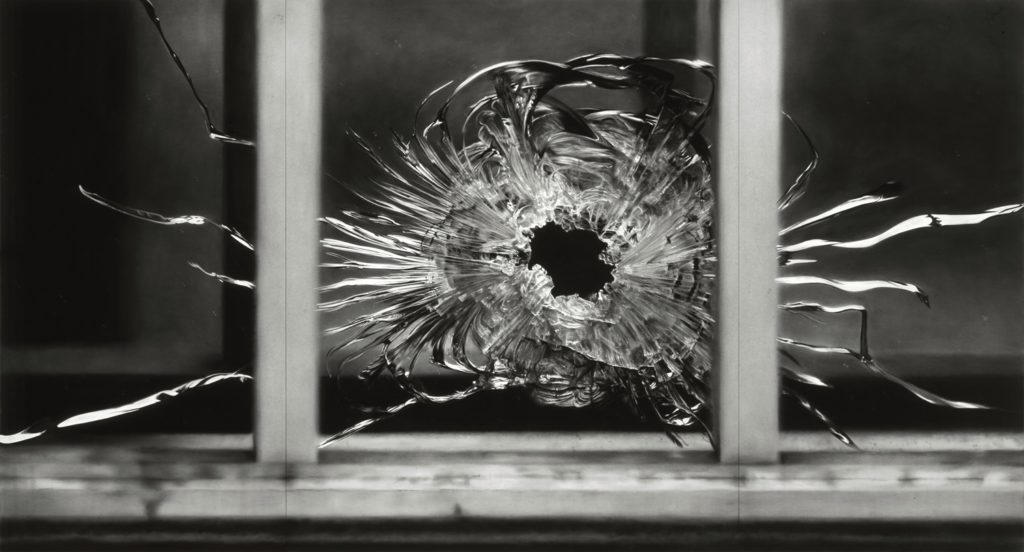
Robert Longo, Untitled (Bullet Hole in Window, January 7, 2015) (2015–16). Charcoal on mounted paper, 76 x 143 inches. © Robert Longo, Ståhl Collection Norrköping, Sweden. (Photo: Courtesy of the artist and Galerie Thaddaeus Ropac; London, Paris, Salzburg)
Right, the Charlie Hebdo piece, where you drew the bullet hole in the window pane. That’s a really jarring and powerful image.
These terrorists attacked artists. They attacked Charlie Hebdo—cartoonists! I had the most amazing thing happen to me. A man who worked at Charlie Hebdo—fortunate enough to have overslept that morning—saw my drawing and sent me this incredible book. It was so touching. He made a book where he redrew my drawing from the hole out, coupled with a beautiful piece of writing.
He wrote about how my drawing had helped him deal with the situation. It blew me away—really blew me away. It was really quite touching. So when something like that happens I think, “Wow, maybe this stuff actually works sometimes.” It’s important that work is evocative on many different levels, and one of them is actually a sense of healing or closure. That to me is incredible. I love it.
Art differs from a movie or time-based work in that art is not linear. Art enables you to create your own narrative. The audience can read it backwards, forwards, however they want… and the experience is always twofold: the way you look at something and the way you remember it.
“Proof : Francisco Goya, Sergei Eisenstein, Robert Longo” is on view at the Brooklyn Museum, New York, September 8, 2017–January 7, 2018.